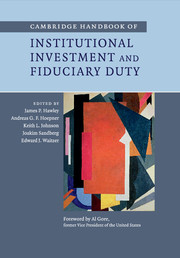Book contents
- Frontmatter
- Contents
- List of figures
- List of tables
- List of contributors
- Foreword
- 1 Introduction
- Part I Fiduciary duty: a global outlook
- Part II Fiduciary duty and the landscape of institutional investment
- Part III Challenging conventional wisdom on fiduciary duty
- Part IV Towards a broader interpretation of fiduciary duty
- Part V Beneficiaries’ roles and viewpoints
- 26 The voice of the beneficiary
- 27 Understanding the attitudes of beneficiaries: should fiduciary duty include social, ethical and environmental concerns?
- 28 Operationalizing socially responsible investment: a nonfinancial fiduciary duty problem
- 29 The preferences of beneficiaries: what can we learn from research on retail investors?
- Part VI Fiduciary duty and governance
- Index
- References
27 - Understanding the attitudes of beneficiaries: should fiduciary duty include social, ethical and environmental concerns?
Published online by Cambridge University Press: 05 April 2014
- Frontmatter
- Contents
- List of figures
- List of tables
- List of contributors
- Foreword
- 1 Introduction
- Part I Fiduciary duty: a global outlook
- Part II Fiduciary duty and the landscape of institutional investment
- Part III Challenging conventional wisdom on fiduciary duty
- Part IV Towards a broader interpretation of fiduciary duty
- Part V Beneficiaries’ roles and viewpoints
- 26 The voice of the beneficiary
- 27 Understanding the attitudes of beneficiaries: should fiduciary duty include social, ethical and environmental concerns?
- 28 Operationalizing socially responsible investment: a nonfinancial fiduciary duty problem
- 29 The preferences of beneficiaries: what can we learn from research on retail investors?
- Part VI Fiduciary duty and governance
- Index
- References
Summary
Introduction
There is currently a heated debate among fund managers, academics and stakeholders alike concerning to what extent institutional investors like pension funds should take social, ethical and environmental (SEE) considerations into account in investment decisions. Proponents argue that “with great power comes great responsibility,” that is, that pension funds in industrialized nations – which today hold assets equivalent to (on average) 76 percent of the GDP of their respective countries (IFSL 2009) – for this reason also have a responsibility to care about the long-term prosperity and well-being of their countries’ populations (Sethi 2005; Viederman 2008). By integrating SEE concerns, it is argued that pension funds would incentivize companies listed on the stock market to promote sustainable development and more long-term growth (Kiernan 2009; Woods 2009). This is then, it is said, what a responsible pension fund ought to do. But is it really asset owners’ role to take a stand on such nonfinancial issues?
A central point of discussion in this context concerns how to understand the legal responsibilities owed by trustees to their beneficiaries; their so-called fiduciary duties. Pension trustees are under a legal obligation to manage their funds in the best interests of the ultimate recipients of the funds, that is, the future pensioners (Freshfields Bruckhaus Deringer 2005; Whitfield 2005). “Interests” have over time become equated with short term “financial interests,” as captured by prevailing finance theories, and has been thought to preclude fiduciaries from taking SEE concerns into account in investment decisions (Hawley et al. 2011; Hess 2007). However, this view is now being challenged on many fronts. A common argument in the debate is that “interests” can be understood more broadly to also include, for instance, beneficiaries’ ethical interests or welfare interests (Lydenberg 2012; Sandberg 2013). As Richardson (2007: 158–9) argues: “If beneficiaries share a moral objection to a particular form of investment, it could be construed as for their benefit if the trust avoided that investment, possibly even at the cost of a lower financial return.”
- Type
- Chapter
- Information
- Publisher: Cambridge University PressPrint publication year: 2014
References
- 1
- Cited by

